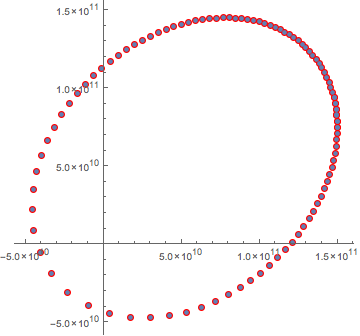I am trying to write a code to fit actual data of the orbit of a star with Mathematica 8.
First I tried to write a code to fit a mock orbit, using the Application with differential equations (the first one) as a guide (see here): in that case there is only 1 function I need two (x,y positions) for my orbit.
Here is my attempt up to now:
Msun = 2*10^30;
M = 4.3*10^6;
G = 6.67*10^-11;
UA = 150*10^6;
(*mock orbit*)
s = NDSolve[{Vx'[t] == (-M*G*X[t]*Msun)/(X[t]^2 + Y[t]^2)^(3/2),
Vy'[t] == (-M*G*Y[t]*Msun)/(X[t]^2 + Y[t]^2)^(3/2),
X'[t] == Vx[t], Y'[t] == Vy[t], Vx[0] == #1, Vy[0] == #2,
X[0] == #3, Y[0] == #4}, {Vx, Vy, X, Y}, {t, 0, 10^4}] &;
tempi = Range[0, 10^4, 10^2];
Xdat = Flatten[
Evaluate[X[#] /. s[0, 4*10^7, 1000*UA, 500*UA]] & /@ tempi, 1];
Ydat = Flatten[
Evaluate[Y[#] /. s[0, 4*10^7, 1000*UA, 500*UA]] & /@ tempi, 1];
dati = Transpose[{Xdat*, Ydat}];
ListPlot[dati]
(*this is the model*)
orbita[a_?NumberQ, b_?NumberQ, c_?NumberQ, d_?NumberQ,
e_?NumberQ] := (orbita[a, b, c, d, e] := {X, Y} /.
NDSolve[{Vx'[t] == (-e*G*X[t]*Msun)/(X[t]^2 + Y[t]^2)^(3/2),
Vy'[t] == (-e*G*Y[t]*Msun)/(X[t]^2 + Y[t]^2)^(3/2),
X'[t] == Vx[t], Y'[t] == Vy[t], Vx[0] == a, Vy[0] == b,
X[0] == c, Y[0] == d}, {Vx, Vy, X, Y}, {t, 0, 10^4}]);
FindFit[dati,
orbita[0, 4*10^7, 1000*UA, 500*UA, Mc][X, Y], {{Mc, 10^6}}, t]
I get the following error:
FindFit::nrlnum:"The function value {-7.97408*10^10+Null[{X,Y}],<<49>>,<<51>>} is not \ a list of real numbers with dimensions {101} at {Mc} = {1.`*^6}."
I have also tried with:
FindFit[dati,
orbita[0, 4*10^7, 1000*UA, 500*UA, Mc][X, Y], {{Mc, 10^6}}, {X,Y}]
but I get another error:
FindFit::fitc: Number of coordinates (1) is not equal to the number of variables (2)
Where are my errors?


orbita[]definition and usage. You need more training on easier things $\endgroup$:=instead of=in second eq. in def. oforbita; you should have{X[t], Y[t]} /. NDSolve...and no[X, Y]inFindFit. But the real question is whetherFindFitcan fit 2D output data as a function of 1D input. It seems to do only multivariate 1D fitting; you want univariate 2D. $\endgroup$Mc, the fitted var isn't used anywhere, and a few more errors too. The real question could be how you should approach a complex problem: one step at a time $\endgroup$